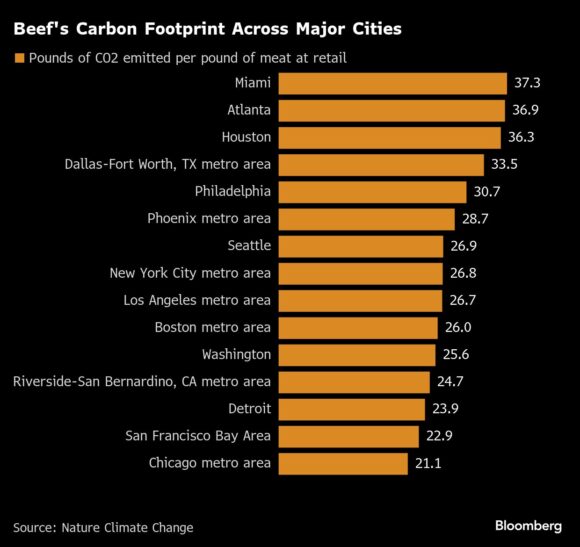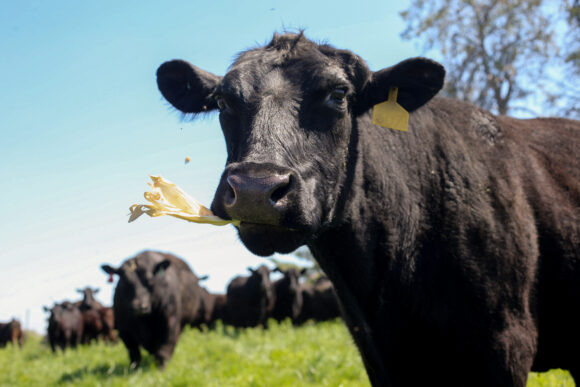Beef is notoriously bad for the environment. Just how bad depends a lot on where in the US you eat it.
The carbon footprint of a burger is bigger in Houston than San Francisco, and in Dallas compared with Chicago, according to a new study published in Nature Climate Change on Monday.
The authors, who mapped livestock supply chains from feed to grocery store, found the biggest influence on beef’s greenhouse gas emissions was the type of cows the meat was sourced from. How far the meat traveled was only a minor source.
Of the 3,500 or so cities the researchers examined, Higginsville, Missouri, had the largest carbon footprint per pound of beef, and Auburn, Indiana, the lowest — to the point that a carnivore there would need to eat nearly five servingsto generate the same level of emissions as one serving in Higginsville.
“Where you live can influence what the environmental impacts of your meat consumption are,” says Benjamin Goldstein, an assistant professor at the University of Michigan and lead author of the study. “You get different types of meat depending on where you live.”

Location, location, location
Greenhouse gas emissions vary so much because of location-specific factors that are not readily apparent to consumers at the grocery store, like regional differences in where animals come from, he says. In Midwestern cities like Chicago, beef is more likely to come from culled dairy cows, making it more environmentally friendly than in Texas cities like Houstonand parts of California, which rely more on dedicated beef herds. Beef from dairy cows is assigned a lower carbon footprint because some of the emissions are attributed to the milk the animals spend most of their lives producing.
Depending on where an animal’s feed is produced, it can also be more or less carbon intensive, due to differences in how much irrigation and fertilizer are used, Goldstein says. Corn that’s grown to feed beef is four and a half times more water intensive than corn used for pork because much of it is sourced from Nebraska, Kansas and Texas, states that use a lot of irrigation, compared with Iowa, Minnesota and Illinois for pork, another study found.
The new research determined the emissions of meat in each city, which it dubbed the “hoofprint,” using a University of Minnesota model that tracks feed-producing counties and links them to areas where animals are raised and slaughtered. Goldstein notes that one limitation of the approach is that it assumes the food supply chain will optimize for the shortest and lowest-cost transportation routes, which might not always happen.
The geographic differences don’t change the conventional wisdom about eating less beef to cut one’s carbon footprint. Switching to pork or chicken is, in most cases, less environmentally harmful, because the two tend to produce fewer emissions than beef, the authors say.
All told, emissions from the meaton plates in American cities surpass the total emissions of medium-sized advanced nations like the United Kingdom and Italy, Goldstein says. In some of the cities examined, emissions from eating meat rivaled those of powering a home. That means eating less beef could have a greenhouse gas benefit similar to an expensive energy retrofit on one’s home, he says.
“It can be an effective way to reduce some people’s carbon footprints and also an affordable way to do that,” he says. “It’ll actually save you money to purchase less beef.”
Was this article valuable?
Here are more articles you may enjoy.



 Foundation Firmed: AM Best Switches View of US Homeowners Insurers to Stable
Foundation Firmed: AM Best Switches View of US Homeowners Insurers to Stable  Applied Systems, Comulate Spar Over Trade Secret Theft Allegations
Applied Systems, Comulate Spar Over Trade Secret Theft Allegations  Baldwin Group to Buy CAC Group for About $1B in Cash and Stock
Baldwin Group to Buy CAC Group for About $1B in Cash and Stock  Florida, East Coast to See Big Insured Losses From More Cat 5 Storms, Researchers Say
Florida, East Coast to See Big Insured Losses From More Cat 5 Storms, Researchers Say 

